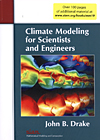- About MAA
- Membership
- MAA Publications
- Periodicals
- Blogs
- MAA Book Series
- MAA Press (an imprint of the AMS)
- MAA Notes
- MAA Reviews
- Mathematical Communication
- Information for Libraries
- Author Resources
- Advertise with MAA
- Meetings
- Competitions
- Programs
- Communities
- MAA Sections
- SIGMAA
- MAA Connect
- Students
- MAA Awards
- Awards Booklets
- Writing Awards
- Teaching Awards
- Service Awards
- Research Awards
- Lecture Awards
- Putnam Competition Individual and Team Winners
- D. E. Shaw Group AMC 8 Awards & Certificates
- Maryam Mirzakhani AMC 10 A Awards & Certificates
- Two Sigma AMC 10 B Awards & Certificates
- Jane Street AMC 12 A Awards & Certificates
- Akamai AMC 12 B Awards & Certificates
- High School Teachers
- News
You are here
Climate Modeling for Scientists and Engineers

Publisher:
SIAM
Publication Date:
2014
Number of Pages:
165
Format:
Paperback
Price:
69.00
ISBN:
9781611973532
Category:
Textbook
[Reviewed by , on ]
William J. Satzer
01/16/2015
The earth’s climate is an immensely complicated system with a number of components that are just not well understood. Our knowledge of the relevant physics is incomplete, and some necessary aspects of the mathematics are not well developed, particularly for oceanic and atmospheric flows. Interactions and feedback between critical elements of climate are also very complex. So it should not be surprising that mathematical modeling of climate is extremely challenging.
Broadly speaking, approaches to climate modeling have taken one of two paths. One focuses on relatively simple conceptual models that attempt to capture critical aspects of climate dynamics. Such a treatment is described, for example, in Mathematics and Climate by Kaper and Engler. The current book follows the other path and explores an ambitious, all-encompassing model, often called a general circulation model. The author describes the principles and practice of very detailed modeling of earth’s climate together with the associated large-scale computational issues. His overall goal is to identify temporal and spatial variations of the state of the climate system and then to reconcile our understanding of the basic physical processes with the available observational data.
The book begins with a discussion of weather and climate observation — what data we have and how we get it. This includes both long-term climate data and more current observations of weather. Substantial variations in the earth’s climate have occurred over geologic time scales. More recent data (that is, from the last 800,000 years) come from Antarctic ice core records. Over this period there have been eight ice ages separated by interglacial periods. Temperatures in these records are not measured (since no thermometers were available) but inferred from temperature proxies such as carbon dioxide retained in the ice or the relative prevalence of isotopes of carbon and oxygen. Data from the modern era (a very, very small slice of the entire climate record) include precise measurements from satellites and other sophisticated sensor systems.
The second chapter introduces the basic equations that model oceanic and atmospheric flow. Working from first principles and using the laws of conservation of mass, momentum and energy, the author presents background and derivations for all the conservation equations that govern oceanic and atmospheric flow. All the relevant components as well as simplifications and approximations are described in some detail.
Following this is an extended discussion of high performance computing and numerical methods for solving the system of coupled partial differential equations of geophysical flow. The major computational costs of climate simulation arise from modeling processes like the radiation balance between reflection and absorption, precipitation and cloud formation, and land surface flux of moisture and heat.
The last two chapters address climate simulations and what we have learned from them. A couple of case studies are included. One is a simulation of paleoclimate using continental positions and earth’s orbital parameters from 100 million years ago. Another looks at the effect of land cover changes since 1750. Changes in land cover influence the earth surface’s albedo: progressions from forest to crops have had a cooling effect because of increased albedo. But a counterbalancing warming effect from reduced evaporation and other hydrological effects has resulted in a small temperature increase overall.
Some of the author’s best material is not in the book but is available at a related SIAM website. One piece, called “Supplemental Lectures” includes both more broadly accessible discussions of climate issues and more detailed technical development supporting the content of the book. Another piece, “MATLAB Exercises” has a short introduction to that software and several examples of using it to investigate aspects of climate.
Bill Satzer (wjsatzer@mmm.com) is a senior intellectual property scientist at 3M Company, having previously been a lab manager at 3M for composites and electromagnetic materials. His training is in dynamical systems and particularly celestial mechanics; his current interests are broadly in applied mathematics and the teaching of mathematics.
See the table of contents in pdf format.
- Log in to post comments




